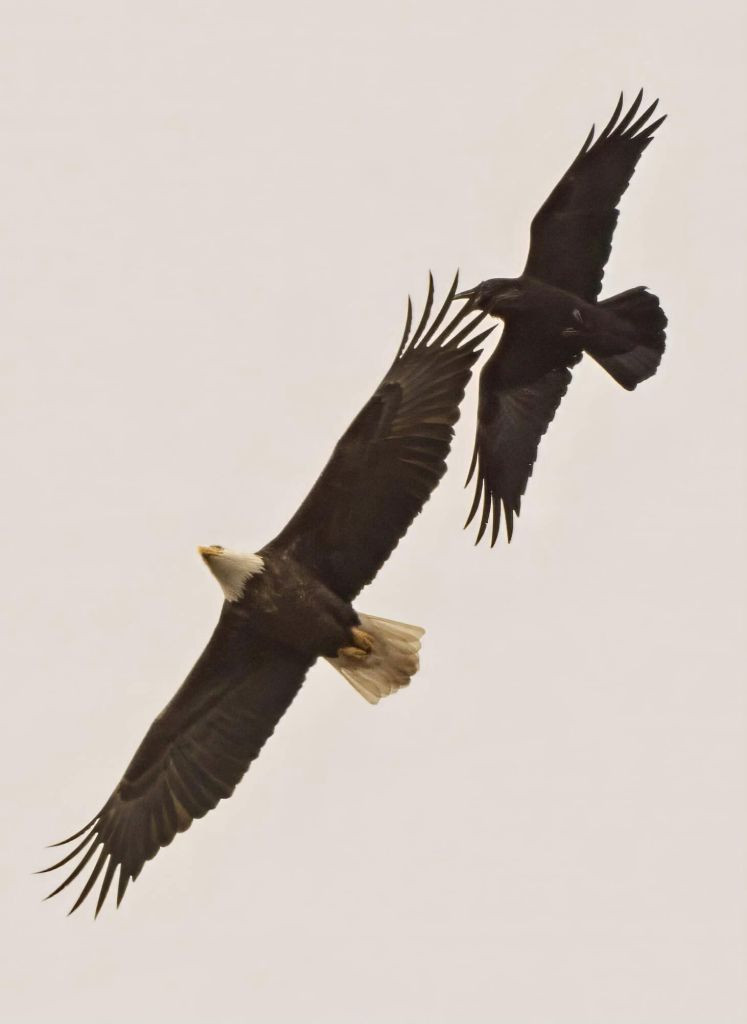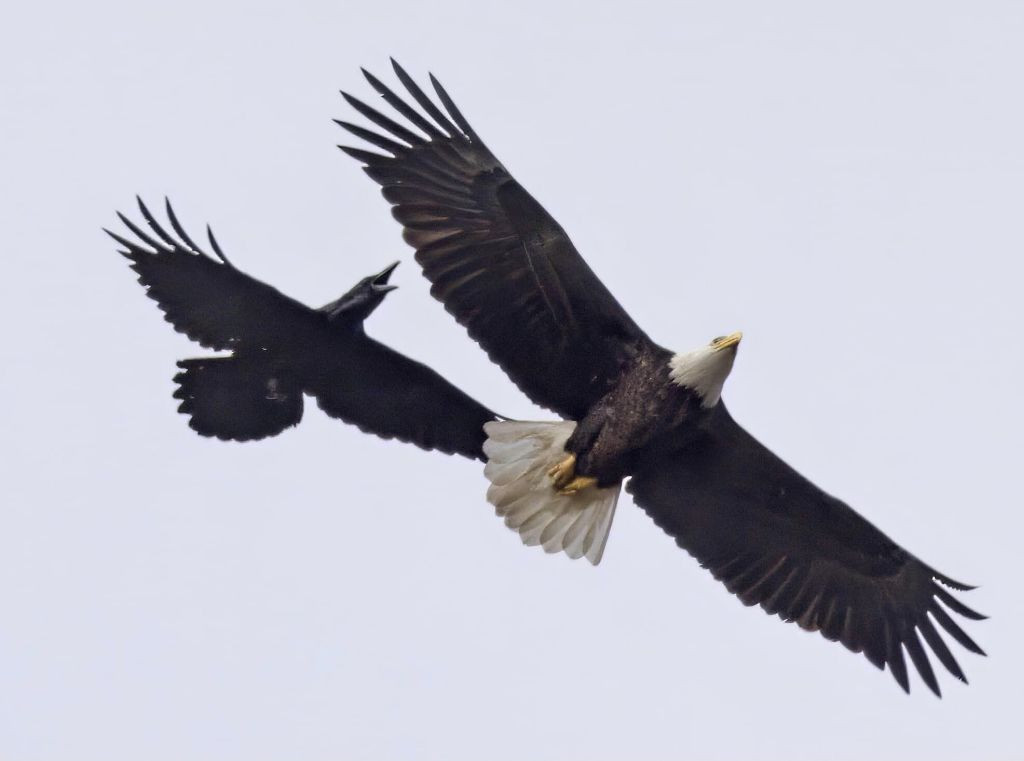Recently, photos captured by Jim McCollum at Hays Woods showcased a raven boldly harassing a new male bald eagle, nicknamed “V.” This interaction, shared on the 40 Acres a.k.a. Hays Woods Enthusiasts Facebook group, sparked an interesting anecdote from Dave Dutzik about crows and eagles. Dutzik recounted a story where crows supposedly land on eagles’ backs and peck at them, prompting the eagles to soar to extreme altitudes. The tale suggests that crows, unable to cope with the thin air at such heights, eventually pass out and fall off. This raises a fascinating question: Do eagles actually fly high to get rid of crows, using altitude as a weapon? Let’s investigate the truth behind this intriguing idea.
 A raven aggressively pursues a bald eagle in mid-air, showcasing a dynamic interaction between the two bird species.
A raven aggressively pursues a bald eagle in mid-air, showcasing a dynamic interaction between the two bird species.
The Crow and Eagle Altitude Myth
The story of eagles using altitude to shake off pesky crows is compelling. It paints a picture of the eagle as a clever strategist, outsmarting the smaller crow with its superior flight capabilities. The core of this myth lies in the assumption that crows are significantly more susceptible to altitude sickness than eagles. But is there any scientific basis to this claim? And how high can these birds actually fly?
 A raven is in close pursuit of a bald eagle from above, illustrating the raven's agility and persistence in the aerial encounter.
A raven is in close pursuit of a bald eagle from above, illustrating the raven's agility and persistence in the aerial encounter.
Bird Flight Altitude: Eagles, Ravens, and Crows
Birds are indeed masters of high-altitude flight. They possess remarkable physiological adaptations that allow them to thrive in environments where humans would struggle to breathe. Studies have shown that birds can breed and fly at altitudes that would be fatal to us without oxygen support. Some species even migrate over the Himalayas at jet-like altitudes. Migratory birds in the Caribbean, for instance, are commonly observed around 10,000 feet, with some reaching twice that height. Long-distance migrants often start at around 5,000 feet and progressively ascend to approximately 20,000 feet, according to Stanford Birds.
When considering crows, ravens, and bald eagles specifically, all are capable fliers. Ravens, like the one harassing the Hays Woods eagle, are known for their acrobatic flight and endurance. Bald eagles, while larger, are also powerful and agile in the air. While precise altitude ceilings for crows and ravens can be harder to pinpoint compared to well-studied migratory species, it’s clear they can fly at considerable heights.
 A bald eagle is captured in flight, being closely followed by a raven from behind, highlighting the interaction between these two birds in their natural habitat.
A bald eagle is captured in flight, being closely followed by a raven from behind, highlighting the interaction between these two birds in their natural habitat.
Why Crows Leave Eagles: Altitude or Annoyance?
So, if both eagles and crows (and ravens) can tolerate high altitudes, is the myth of eagles flying high to get rid of crows plausible? Likely not. The more probable explanation for why a crow might break off its harassment of an eagle at a higher altitude is simply that it gets tired, or it realizes the eagle is no longer reacting as it wants.
As mentioned in the original post, the reason a crow leaves an eagle isn’t due to lack of oxygen. Instead, it’s more likely that the crow simply loses interest when the eagle doesn’t engage or when the effort of chasing becomes too much. The eagle’s strategy isn’t to incapacitate the crow with altitude, but perhaps to simply out-fly or ignore the smaller bird until it gives up. The encounter observed at Hays Woods, and the anecdote it sparked, highlights the dynamic interactions in nature and our ongoing curiosity about bird behavior, even if some tales turn out to be more myth than reality.
For further reading on bird flight and altitude capabilities, explore resources like “High-altitude champions: birds that live and migrate at altitude” and “As High As A Jet.”